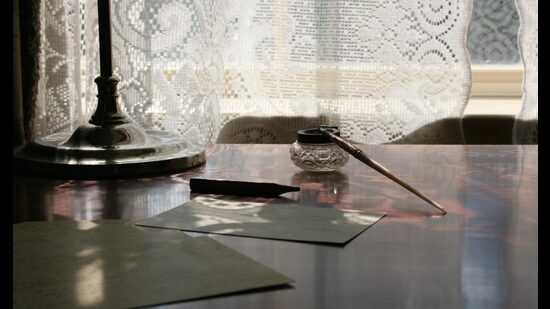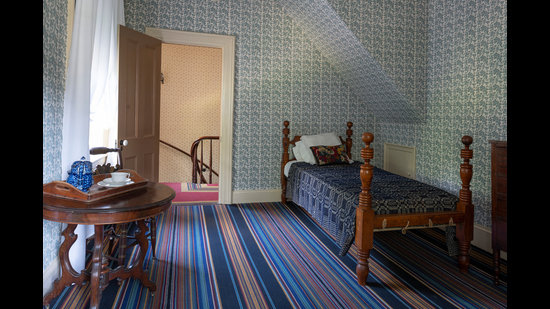Emily Dickinson at work at home
No literary pilgrimage to Massachusetts can be complete without a visit to the Amherst home of one of the most important figures in American poetry
I found a kindred spirit in Emily Dickinson quite early in life. A letter the reclusive author wrote at the age of 23, declining an invitation from a friend, revealed to me that it was possible to be an introvert in this extroverted world. “Should I ever leave home, which is improbable, I will with much delight, accept your invitation; till then, my dear Abiah, my warmest thanks are yours, but don’t expect me. I’m so old fashioned, Darling, that all your friends would stare. I should have to bring my work bag, and my big spectacles…,” wrote Dickinson, slowly creating the legend that surrounded her.

Barely 10 of her 1,800 poems were published before she died, but Dickinson is now celebrated as one of the most important figures in American poetry. Her poems were unique for that time – they were untitled, had short lines, often used slant rhymes, and showcased unusual punctuation and capitalisation. Her poetry often focused on themes like nature, spirituality, society, death, and immortality.

No literary pilgrimage to Massachusetts can be complete without a visit to Amherst, a college town in Massachusetts, where Dickinson was born on December 10, 1830, into a prominent family. Settled in the 1730s and incorporated as a town in 1775, Amherst was named for Jeffrey Amherst, British commander in North America in the French and Indian War. It has developed largely as an educational centre, and is home to a strong academic community, including Amherst College, University of Massachusetts, Hampshire College, Smith College, and Mount Holyoke College.
But Amherst is best known as the town where Emily Dickinson lived.
Patrick Fecher, Associate Director of Communications, Emily Dickinson Museum, says locals are proud to have such a world-renowned poet from Amherst. “We have visitors who travel from all around the world to visit,” he says. The museum celebrates the life and legacy of the poet through two old houses: the Homestead, the birthplace and home of Dickinson, and the Evergreens, located next door and home to her brother Austin, his wife Susan, and their three children. The museum was created in 2003 when the two houses merged under the ownership of Amherst College.
“Together, both these houses tell a more complete story about the reclusive poet, her family, and the time and world in which she lived,” Fecher says.
Dickinson studied at Amherst Academy for seven years. During this time, she met a few people who went on to become her lifelong friends and correspondents, including Abiah Root, Jane Humphrey, and Susan Huntington Gilbert (who later married Dickinson’s brother Austin).
The Dickinson family befriended Benjamin Franklin Newton, a young lawyer, when she was around 18 years old. Their relationship was never romantic, but he was a formative influence. Newton gifted her Ralph Waldo Emerson’s first book of collected poems and introduced her to William Wordsworth’s work, believing in her as a poet. He wrote to her, when dying of tuberculosis, that he would like to live until she achieved the greatness that she was destined to find. Dickinson’s statement of 1862 — “When a little girl, I had a friend, who taught me immortality – but venturing too near, himself – he never returned” — is said to refer to Newton.
Apart from the Bible, Dickinson was influenced by Lydia Maria Child’s Letters from New York, Henry Wadsworth Longfellow’s Kavanagh, and Charlotte Brontë’s Jane Eyre. William Shakespeare also had a strong hold on her imagination, and she referred to his work in letters to friends: “Why is any other book needed?” “Why clasp any hand but this?”

After briefly attending the Mount Holyoke Female Seminary, Dickenson returned to her family home, and lived much of her life in isolation. Townsfolk spoke of her as “the Myth”, and she was known for her white clothing, her disinclination to meet guests, and for rarely leaving what she always called “my father’s house”. She never married, maintained most of her friendships through letters, and found the time to write.
Her poems are typically short with a single speaker who expresses thought and feeling. As in most lyric poetry, the speaker is often identified in the first person. But the “I” did not speak for the poet, as she wrote in a letter to Thomas Wentworth Higginson, an editor, writer, and contributor to the Atlantic Monthly, who later became her correspondent and mentor. “When I state myself, as the representative of the verse, it does not mean me, but a supposed person,” she wrote.
The poet, a keen observer, tapped ideas and images from nature, religion, music, medicine, commerce, law, fashion, and domestic activities to probe universal themes such as love, death, immortality, the wonders of nature, and the identity of the self. She titled fewer than 10 of her almost 1,800 poems, which are now generally known by their first lines or by numbers assigned by editors.
She gave Higginson her own definition of poetry: “If I read a book and it makes my whole body so cold no fire can warm me, I know that is poetry. If I feel physically as if the top of my head were taken off, I know that is poetry. These are the only way I know it. Is there any other way?”
Dickinson’s home -- now the Emily Dickinson Museum - had a huge bearing upon her work. She began to write poetry in earnest during her adult years at the Homestead. “Her most productive period was from 1858 to 1865, and she compiled her poems into small packets now termed “fascicles.” The 10 poems published in her lifetime were all published anonymously and presumably without her permission,” Fecher says.
The museum has the largest and most diverse collection of objects related to Dickinson and her family. “We have more than 8,000 artifacts, including her writing table and chair. The family library and Dickinson’s Bible are also part of it. The heart of the collection, however, are 40 hand-sewn fascicles (manuscript books) in which she copied her poems,” Fecher says.
The Evergreens, meanwhile, serves as an impressive “time capsule” of a prosperous nineteenth-century household in a small New England town. This was the home of Susan Gilbert, the woman who Dickinson had her strongest and most affectionate relationship with in the 1850s. The poet wrote more than 300 letters to her sister-in-law, who played many roles and was “most beloved friend, influence, muse, and adviser”. “With the exception of Shakespeare, you have told me of more knowledge than any one living. To say that sincerely is strange praise,” she wrote in a letter in 1882.
In 1998, The New York Times reported on a study in which infrared technology revealed that a few of Dickinson’s poems seemed to have been deliberately censored to exclude the name “Susan”. At least 11 of her poems were dedicated to her sister-in-law; the dedications were later deleted to perhaps obscure the nature of their relationship, which many scholars have interpreted as romantic.
“Susie, did you think that I would never write you when you were gone away -- what made you? I am sure you know my promise far too well for that – and had I never said so – I should be constrained to write – for what shall separate us from any whom we love – not “hight nor depth[”],” she wrote in a letter in 1851.
The following year, she wrote in language that combined courtly love and spiritual devotion: “The dishes may wait dear Susie – and the uncleared table stand, them I have always with me, but you, I have “not always,” why Susie, Christ hath saints manie – and I have few, but thee – the angels shant have Susie – no – no!”
In 1915, Martha Dickinson Bianchi, Susan’s daughter, in an article in Atlantic Monthly, described her Aunt Emily: “Her devotion to those she loved was that of a knight for his lady.”
Dickinson rarely left her home. In her later years, the poet had a romance with Judge Otis Phillips Lord, a friend of her father who began courting her when he became a widower. Her later life was marked by illness and death. Her father died in 1874, her mother suffered a stroke in 1875, her beloved nephew Gib breathed his last, aged only eight, in 1883 while Otis Lord passed away in 1884. She took ill after Gib’s death, writing “The Crisis of the sorrow of so many years is all that tires me.” Dickinson remained in poor health until her death on May 15, 1886. She was buried four days later in the town cemetery.

Interest has risen once more in Dickinson’s life and work in recent times due to the Dickinson Apple+ television series, movies like Wild Nights with Emily, and Taylor Swift’s Evermore album, which possibly references the poet’s One Sister Have I in Our House. These new takes don’t showcase the poet as a withdrawn and reclusive genius but as someone who is rebellious and spirited.
In These Fevered Days: Ten Pivotal Moments in the Making of Emily Dickinson, Martha Ackmann writes: “On the surface, Emily Dickinson lived an ordinary life: she resided in one town, went to school, never held a job, lived in her parents’ home, remained single, and died at age 55.” But her internal world was “extraordinary”. “She loved passionately, wrote scores of letters, anguished over abandonment, fought with God, found ecstasy in nature, embraced seclusion, was ambivalent towards publication, and created 1,789 poems that she tucked into a dresser drawer,” Ackman says.
The museum reveals how Dickinson’s life and poetry were shaped by her home. The Advisory Council on Historic Preservation website says it all: “In this house, Emily Dickinson changed American literature and created art that forced many to question what it meant to define poetry.”
Teja Lele is an independent editor and writes on books, travel and lifestyle.
All Access.
One Subscription.
Get 360° coverage—from daily headlines
to 100 year archives.



HT App & Website






